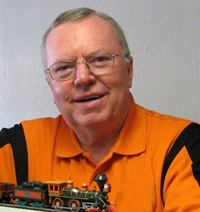Current News "Help Me I am Melting"
The Bigger Issue:
Why is this happening to many locomotives built in the last few years and how do we prevent it or even worse prevent fusing traces on expensive sound decoder boards?
Why did the wires melt?
Current being dissipated as heat melted the insulation.
Where did the current come from?
When one entire truck is on a rail of opposite polarity than the other entire truck the track current passes thru the wires connecting the trucks to the Decoder. (When a locomotive is run into a turnout that is set against it the flywheel may carry the loco far enough such that the whole lead truck is in a section of track of the opposite polarity as the rear truck. In this situation the wires that connect the trucks to the decoder are now conducting the full track current. With a 5 Amp booster connected to the track the wires may have to conduct 5 Amps of current until the circuit breaker in the booster opens the circuit. The wires in your loco or the traces on your decoder will carry this current and convert it into heat. Yes, your locos wires become resistive heating elements. The fine, flexible wires used in model locomotives today will heat up fast and even in some cases fuse (break open) when conducting the track current from one wheel set to another.) A 3 axel truck does not seem to make the clean break from one polarity to the other by flywheel momentum. In this case the truck caries the current from wheel to wheel and does not conduct to the wires and provides a direct short.
How much current is there?
There is the full current of the booster or in NCE a Pro Cab case 5 Amps or 10 Amps are available ( A Power Cab has 2 amp peak current).
How long does it take for the booster’s breaker to open?
***** Additional Information found in the control panel of the layout****
This depends on the load that the short puts on the booster. A problem with fine wire is that it has a higher resistance than say a quarter put across the tracks. Placing a 12 volt 21 watt automotive lamp in the track circuit will light the lamp and limit the current to 1.75 amps and never open the breaker.
If the quarter test worked and opened the booster’s breaker why didn’t the loco’s short?
Look at the thickness of the quarter and then look at the wire. The quarter can carry much more current with less resistance than the thin wire and has less resistance. If there is a signal light in series with the track circuit more current may remain on the track.
So how do we avoid this problem?
Create power districts with Circuit Breakers.
A 5 Amp booster’s output may be broken up into a number of power districts or sections of track on a layout. Each district has access to the power of the booster but may limit the current available to the district and provide a fast acting circuit breaker for the district.
Sound Locomotives require more power and if I limit the current will I limit the number of locomotives I can run on my layout?
By adding power limiting devices to your layout you limit the amount of current available to each of the power districts but not to the whole layout. On a large layout you may have 2 or more 5 Amp boosters providing more current or power to operate a large collection of sound locomotives, however having 5 power districts connected to each booster and breaking up the layout into sections or power districts you may limit the current in each district. An additional advantage is that if there is a short in one district the rest continue to operate without shutting down. A switch engine shorting in a yard will not shut down the main line train passing if the main is on a different power district.
Updated 06/17/15
Join us in the “Greatest Hobby” as a member of the TLMRC.

